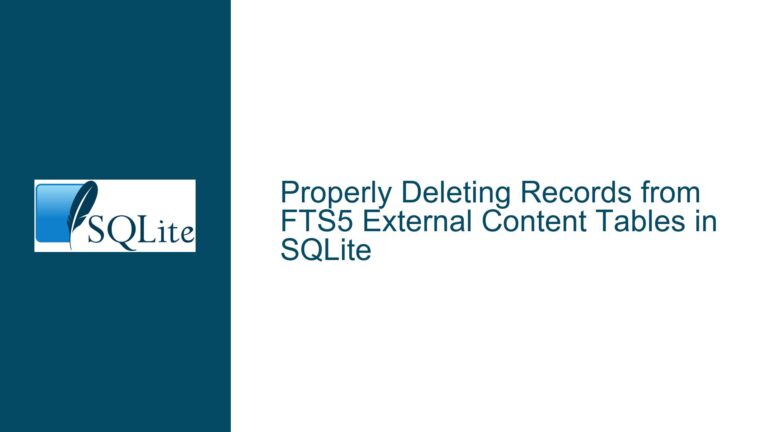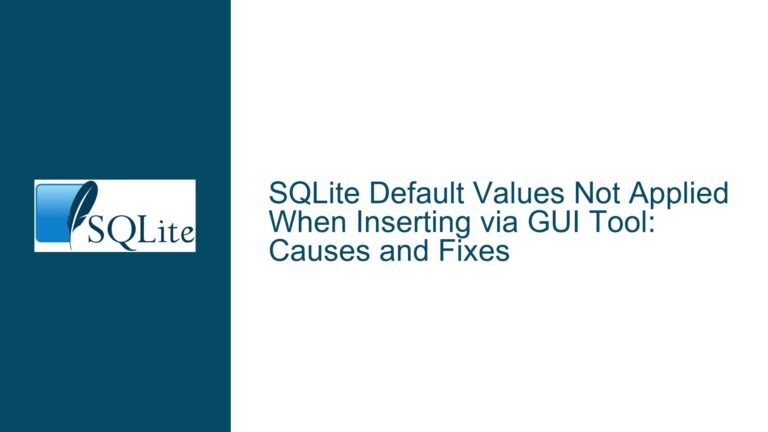Efficiently Processing Multiple CSV Files in SQLite3.exe Without Repetitive Code
Understanding the Core Challenge: Dynamic CSV Iteration in SQLite CLI
SQLite’s command-line interface (CLI) is a powerful tool for data manipulation, but it lacks native support for iterative operations, such as looping over a list of files. This limitation becomes particularly acute when processing multiple CSV files with similar schemas, as seen in workflows involving large datasets like UK NHS treatment waiting times. The absence of procedural logic (e.g., FOR loops) forces users to write repetitive SQL code for each file, leading to bloated scripts that are difficult to maintain. This guide dissects the problem, explores underlying causes, and provides robust solutions to automate CSV processing within SQLite’s constraints.
The Mechanics of Repetitive CSV Processing Workflows
1. Manual Script Repetition: A Fragile Approach
The original workflow involved manually writing SQL code for each CSV file. For example, the user created a virtual table for each CSV file using the vsv extension, inserted data into a staging table, and repeated this process 50 times. This approach has critical drawbacks:
- Code Duplication: Each file requires identical
CREATE VIRTUAL TABLE,INSERT, andDROP TABLEstatements, differing only in filenames and census dates. - Maintenance Overhead: Adding or removing files demands manual edits, increasing the risk of errors.
- Scalability Issues: Processing hundreds of files becomes impractical due to script length and execution time.
2. SQLite CLI’s Lack of Procedural Constructs
SQLite’s CLI is designed for interactive use and batch execution of SQL scripts, not for procedural programming. Key limitations include:
- No Native Looping Syntax: Unlike programming languages, SQLite CLI lacks
FOR,WHILE, orLOOPconstructs. - Limited Variable Substitution: Parameters cannot be dynamically injected into SQL statements at runtime without external tooling.
- Stateless Execution: Each command runs in isolation, making it challenging to retain context between operations (e.g., iterating over a file list).
3. Schema and Data Consistency Challenges
The NHS dataset’s structure introduces additional complexity:
- Dynamic Column References: Columns like
[Gt 00 to 01 Weeks SUM 1]are referenced in arithmetic expressions, requiring precise alignment across files. - Excel Formula Integration: The
mean_waitcolumn embeds an Excel formula (=INT(IF(...))), which must be preserved during batch processing. - Unique Constraint Management: The
UNIQUE(census, provider, department, dataset)constraint necessitates careful handling of conflicts during bulk inserts.
Root Causes of Inefficiency in SQLite CSV Processing
1. Static SQL Scripts vs. Dynamic Inputs
SQL scripts are inherently static, while filenames and census dates are dynamic inputs. Without a mechanism to parameterize these values, each file’s processing logic must be hardcoded. This violates the DRY (Don’t Repeat Yourself) principle and complicates script maintenance.
2. Overreliance on External Tools
The SQLite CLI often relies on external scripting languages (e.g., Python, Lua) to generate SQL code dynamically. While effective, this introduces dependencies that undermine the goal of a self-contained SQLite solution. For example, the user initially resorted to a Lua script to generate a monolithic SQL file, which works but deviates from a pure SQLite workflow.
3. Inefficient Use of SQLite Extensions
The vsv extension simplifies CSV ingestion but does not address the broader issue of iterating over files. Users may overlook SQLite’s built-in capabilities, such as temporary tables or the generate_series function, which can automate repetitive tasks when combined with dynamic SQL generation.
4. Excel Integration Constraints
Exporting results directly to Excel via .excel complicates automation. Excel formulas embedded in SQL output (e.g., mean_wait) require careful handling to ensure they render correctly, especially when rows exceed Excel 2000’s limits.
Strategies for Automating CSV Processing in Pure SQLite
1. Dynamic SQL Generation Using generate_series
SQLite’s generate_series table-valued function can simulate loops by generating sequences of values. This enables dynamic construction of SQL statements based on a list of files stored in a table.
Step 1: Create a File List Table
CREATE TABLE filelist (
filename TEXT PRIMARY KEY,
census DATE
);
INSERT INTO filelist (filename, census) VALUES
('/MyProjects/#NHSWaitingTimes/201704.csv', '2017-04-30'),
('/MyProjects/#NHSWaitingTimes/201705.csv', '2017-05-31'),
...;
Step 2: Generate SQL Statements Programmatically
Use generate_series and string concatenation to create a script that processes all files:
.headers off
.mode list
.separator ""
.output process_files.sql
SELECT
'CREATE VIRTUAL TABLE temp.vsv USING vsv(filename="' || filename || '", header=yes);' ||
'INSERT OR IGNORE INTO waiting SELECT ''' || census || ''' AS census, ' ||
'[Provider Org Name], [Treatment Function Name], [RTT Part Description], ' ||
'sum(([Gt 00 to 01 Weeks SUM 1]*1) + ... + ([Gt 52 Weeks SUM 1]*52)), ' ||
'sum([Total]), sum([Patients with unknown clock start date]), ' ||
'sum([Gt 52 Weeks SUM 1]), sum([Total All]), ' ||
'''=INT(IF(INDIRECT("F" & ROW())>0, ...))'' AS mean_wait ' ||
'FROM vsv WHERE [Treatment Function Name] <> ''Total'' ' ||
'GROUP BY census, [Provider Org Name], [Treatment Function Name], [RTT Part Description]; ' ||
'DROP TABLE vsv;'
FROM filelist;
.output stdout
.read process_files.sql
Advantages:
- Eliminates manual script repetition.
- Centralizes file metadata in a single table.
- Uses SQLite’s native capabilities without external dependencies.
Pitfalls:
- Requires careful escaping of quotes and special characters.
- May hit command length limits for very large file lists.
2. Leveraging Temporary Tables for Batch Processing
Temporary tables can store intermediate results, reducing the need for repeated virtual table creation.
Step 1: Create a Consolidated Staging Table
CREATE TEMP TABLE staging AS
SELECT
census,
[Provider Org Name] AS provider,
[Treatment Function Name] AS department,
[RTT Part Description] AS dataset,
([Gt 00 to 01 Weeks SUM 1]*1) + ... + ([Gt 52 Weeks SUM 1]*52) AS months_sum,
[Total] AS upto52_count,
[Patients with unknown clock start date] AS unknown_count,
[Gt 52 Weeks SUM 1] AS over52_count,
[Total All] AS case_count
FROM vsv;
Step 2: Process All Files in a Single Pass
Use UNION ALL to combine results from multiple vsv virtual tables:
INSERT INTO waiting (census, provider, department, dataset, months_sum, ...)
SELECT '2017-04-30', provider, department, dataset, sum(months_sum), ...
FROM staging
WHERE [Treatment Function Name] <> 'Total'
GROUP BY ...;
Advantages:
- Reduces redundant
CREATE/DROP TABLEoperations. - Simplifies aggregation by consolidating data upfront.
Pitfalls:
- May consume excessive memory for very large datasets.
- Requires consistent schemas across all CSV files.
3. Hybrid Approach: SQLite CLI + Lightweight Scripting
When pure SQLite solutions are impractical, a minimal scripting layer can generate dynamic SQL without sacrificing portability.
Example: Python Script for SQL Generation
import os
files = [
('/MyProjects/#NHSWaitingTimes/201704.csv', '2017-04-30'),
...
]
template = """
CREATE VIRTUAL TABLE temp.vsv USING vsv(filename='{}', header=yes);
INSERT OR IGNORE INTO waiting SELECT '{}' AS census, ...;
DROP TABLE vsv;
"""
with open('dynamic_script.sql', 'w') as f:
for filename, census in files:
f.write(template.format(filename, census))
os.system('sqlite3.exe < dynamic_script.sql')
Advantages:
- Minimal external dependency (e.g., Python is preinstalled on many systems).
- Preserves the benefits of a single SQL script for execution.
Pitfalls:
- Introduces a dependency on Python or another scripting language.
- Requires careful path handling for file locations.
Best Practices for Sustainable CSV Workflows
Schema Validation:
- Use
PRAGMA quick_check;to verify database integrity after bulk inserts. - Validate CSV headers programmatically before processing.
- Use
Performance Optimization:
- Wrap bulk inserts in transactions:
BEGIN; ... COMMIT;. - Use
PRAGMA journal_mode = WAL;for concurrent read/write operations.
- Wrap bulk inserts in transactions:
Error Handling:
- Add
ON CONFLICTclauses to handle duplicates gracefully. - Log errors to a separate table using
INSERT INTO errors SELECT ... WHERE [condition];.
- Add
Excel Integration:
- Split large outputs into multiple Excel files using
.onceand.excel. - Use
.mode csvfor Excel-compatible formatting.
- Split large outputs into multiple Excel files using
Conclusion
While SQLite’s CLI lacks native looping constructs, creative use of dynamic SQL generation, temporary tables, and minimal scripting can automate CSV processing workflows effectively. By centralizing file metadata, leveraging generate_series, and embracing hybrid approaches, users can eliminate repetitive code while maintaining the simplicity and portability of a SQLite-centric solution.






